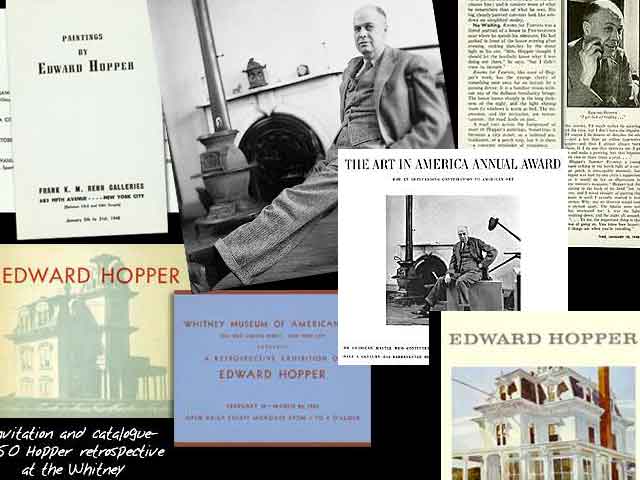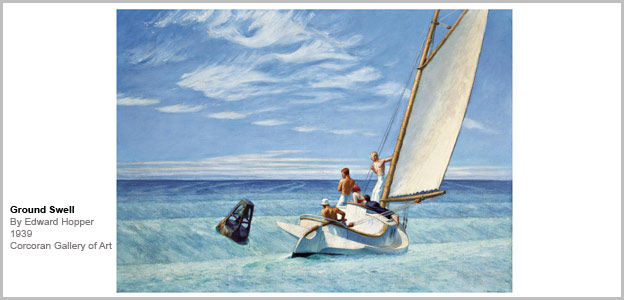
Collage of images from the Smithsonian American Art Museum’s Edward Hopper Scrapbook.
Hopper is perhaps mainly known for his studio based paintings but of course he also made many of his paintings on-site, especially his watercolors. His influence on contemporary realism can’t be underestimated and I continually find inspiration and insight whenever I return to his work. I recently read Linda Nochlin’sGail Levin’s Edward Hopper: An Intimate Biography, a terrific read which has got me thinking more about him lately.
Here is a link to a wonderful online scrapbook produced by the Smithsonian American Art Museum gives us a sampling of Hopper’s paintings, including some seldom seen watercolors, reviews of shows, catalog covers, photos and other memorabilia. It also includes a link to a real audio file that is Edward Hopper discusses his philosophy on art. Edward Hopper: Great art is the outward expression of an inner life in the artist, and this inner life will result in his personal vision of the world. No amount of skillful invention can replace the essential element of imagination.
Here is a link to the page with the Audio file However, I couldn’t get the audio file to play but maybe they were having problems on their server or maybe it was something on my end. Not to worry, you can also read the transcription of this interview here.
Also, several other videos, some for sale, audio files as well as other links and many images of Hopper can be found on this National Gallery of Art page.
A video (about an hour) produced by the National Gallery of Art Center for Advanced Study in the Visual Arts, Wyeth Lecture in American Art 2007 of a lecture given by Alexander Nemerov, a Yale Art Historian discussing his interpretation of Hopper’s Ground Swell of 1939 – where he makes a convincing case for the painting being about Hitler’s invasion of Poland. The lecture is fascinating and opens up new ways of looking at Hopper’s work of this period, the introduction was a tad long but If you wait till the whole video loads you can right click on it and save it to your hard drive and scrub the playbar to your heart’s content. For more information about this lecture and Alexander Nemerov you can check out this link to a Washington Post article about him – worth the read.
Finally, here are a couple of youTube videos that might put you in a Hopperesque state of mind. (the particular Benny Goodman soundtrack disconnects with the “moodiness” of Hopper’s paintings but otherwise a great slide show. The other “An Afternoon Daydream” video is almost embarrassingly “arty” but has it moments.






When I first began in art in the 1960’s I was an abstract painter, but I discovered books on Edward Hopper in my college art library. I kept going back to look at them- the mood from his masterful use of light and shadow just got under my skin in a good way. Before long I threw in the towel and started doing realist paintings.
In 1983 the current owners of Hopper’s Cape Cod studio bought some of my paintings and invited me to stay and work in the Hopper studio. Next year I’ll be going back for my 13h “residency” there.
The studio itself is revealing. Hopper designed the studio himself. It is a small place, but fully half of its space is devoted just to his big painting room with its 10′ tall north-facing studio window. It allow that, the bedroom and kitchen had to be small, and the bathroom is like it is out of a doll house. It shows the centrality of painting in Hopper’s life.
Really, that’s where he lived.
I have a some photos of inside of Hopper’s studio on my website and have written a few blog posts about Hopper and his Cape Cod studio- http://www.philipkochpaintings.blogspot.com
Hard shoes to fill, Mr. Koch. I’d be utterly intimidated. And would probably sleep outside.
I would like to mention that I’ve posted a few articles about Hopper on the Traditional Fine Arts Organization website. TFAO is a clearing-house of scholarly and/or intelligently informed texts on American representational painting. There is nothing like it – and it’s absolutely free! I’m bad at URL’s and don’t have one. But TFAO would be enough to get you there. Common sense will get you to my articles.
I’ve also written a play about the Hopper marriage – though I don’t use Jo or Edward’s real names. It is called “Two Lights”.
I couldn’t help myself and watched the videos. The Goodman soundtrack piece, though exciting in itself, does not capture the Hopper spirit and is fundamentally intrusive. Poor choice, but good lighting. The Lawson essay is more layered and ultimately more satisfying. I could have done without the valiumish voice of the narrator, but that’s a minor quibble. It came much closer to expressing Hopper’s interior world – a place so many of us have entered with a sense of awe, expectancy, yearning, and frustration.
Finally: Linda Nochlin’s biography? It’s unfortunately Gail Levin’s – who clearly dislikes Hopper as a person and, possibly, as an artist as well. It’s not a badly written thing, but the author’s disdain for her subject “shines” through every pore. Ms. Levin inherited the mantle of Hopper scholarship from Lloyd Goodrich, who was at least an admirer. I’m not sure how these things are handled. Did Levin take the withered laurels from Goodrich himself or seize them from a trembling hand and run off with them? Whatever the case, she’s done no favors for Edward Hopper. Fortunately, his work is powerful enough to burn its detractors away, as the morning sun will do to wreathes of fog.
One of the better essays on Hopper’s work was written by John Canaday. It’s called something like The Loneliness of the Long-Distance Runner, after the title of a recent (1960’s-era) novel. (I believe Canaday wrote the piece while Hopper was still alive.) Candady clearly likes and understands Hopper’s work, as well as its specific moment in American art history – which will very likely endure for some time to come.
Sorry about the mix-up with Linda Nochlin and Gail Levin – I must learn to proofread more carefully! I just changed it, thanks for pointing that out. I agree that Gail Levin did seem to have problems with Hopper as a person but its true someone can be a total jerk and still be a great painter – as with Picasso and countless others. I liked the depth of her research and found it a good read about his life none the less.
Did you see the other National Gallery of Art video with the lecture given by Alexander Nemerov That was the only video linked here that was exceptional. The others were more amateur “fan” videos I found on youTube.